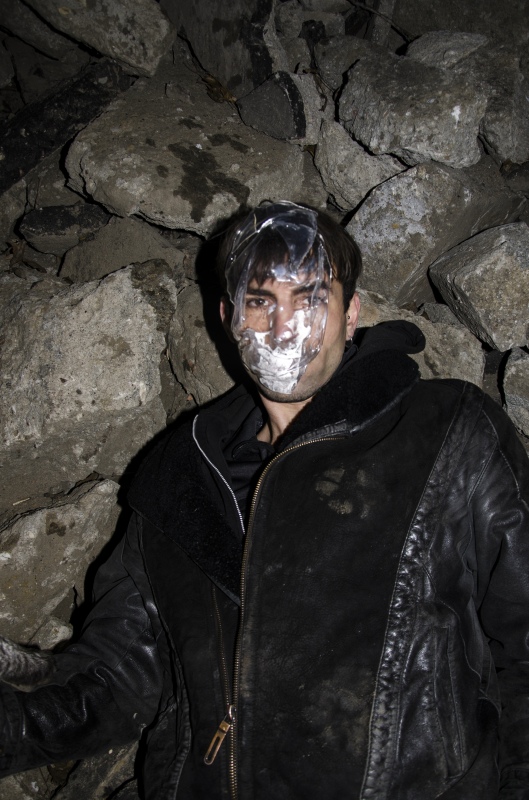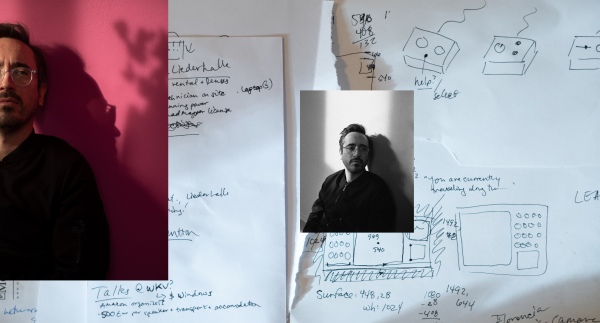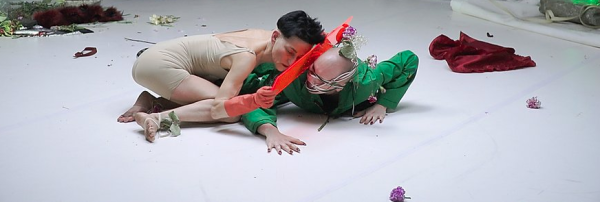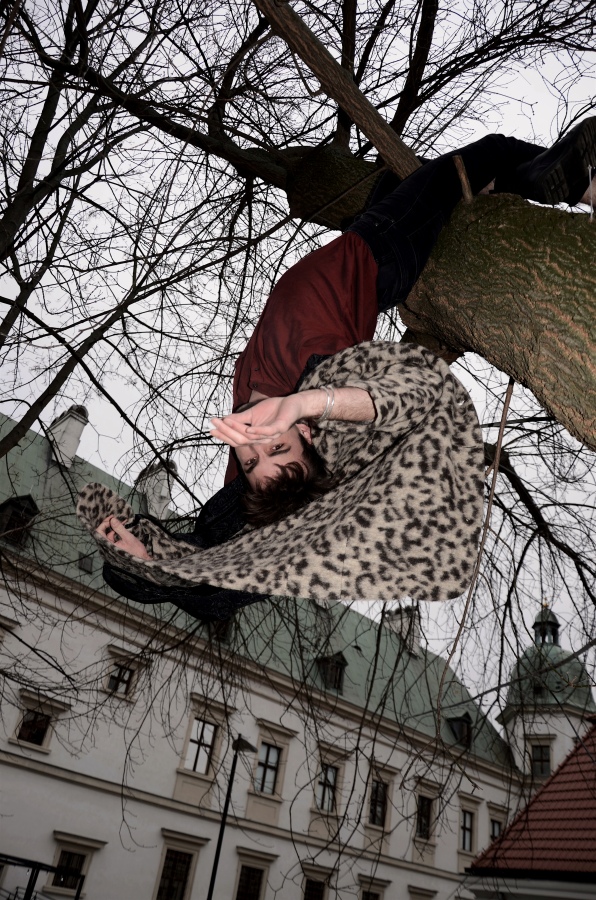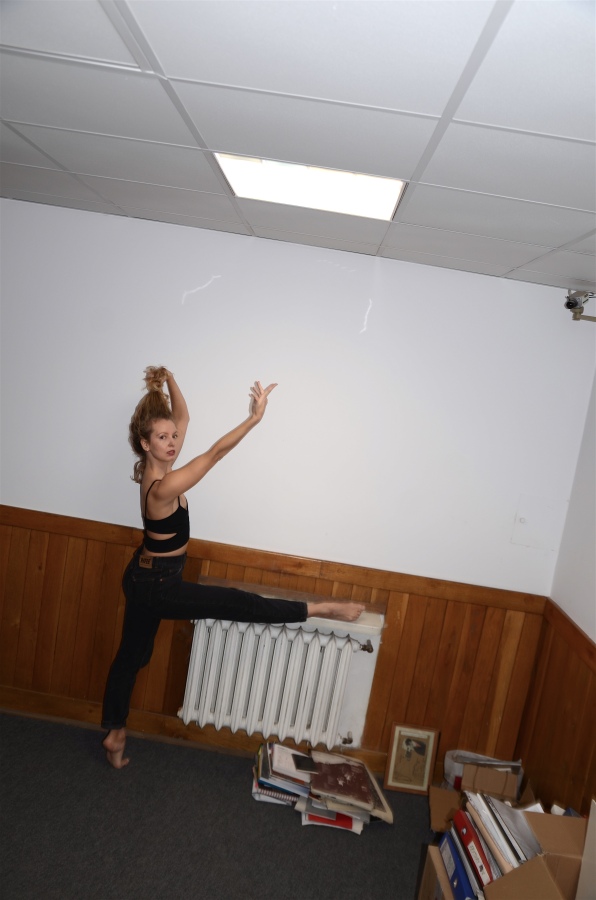Other bodies
Nagi Gianni in conversation with Dominik Skrzypkowski
-
You are a visual artist but you do not focus on objects. In your performances the hybridised bodies and objects are in constant movement. How would you describe the importance of movement in your practice?
-
The works I produce start from images coming together in a sort of collision, so the movement factor plays an important role. I work with images, film and performance. There is the movement that brings to the image, the movement between the images and the movement that such images bring on. In addition, I have always been working with the body, so the notion of movement also comes through the body’s motion.
-
-
Some people still consider visual arts as solely creating objects…
-
When I’m confronted with an art work by a visual artist such as a painting or sculpture, I’m interested in works that move me in a physical way as a spectator. I am not fascinated by the object itself, but rather for its potential to create movement in me, be it interior or exterior. I need to feel physically engaged to what I see. I think this dimension is what I brought directly into my practice.
-
-
How did you discover such desire?
-
Initially I would visit art exhibitions. I felt there was something interesting, but when I started going to see more and more performing arts, then I felt the desire for a physical engagement. This was closely related to people: on stage, in the audience and in social meetings after the show. It was not just an object standing in a space by itself, but rather an arena for human exchange, creating a sense of community. I guess that was something that I needed to bring into my practice.
-
-
You started with video art and films.
-
Making films was like a protected area of work for me. In the creative process it was a way of having a more intimate space for creation, having a group of people with whom you do something together, keeping a distance from the moment of showing it to the audience. It was a time when I needed this kind of more intimate bubble. It is something that has evolved over recent years; now I’m more interested in presenting something live to the audience. It involves taking another kind of risk.
-
-

-
-
How do you remember your first performance?
-
My first performative work was Splendid and it helped me to understand my process of producing a work in this specific medium. I had to face the different temporality it involved, the possibilities and limitations it generated, and in general a change of perspective. When I was making films, it was easy for me to keep everything in frame, having extra control through the editing process over how I wanted the work to be seen. But in showing something live, there is a moment when you cannot control what is happening, you have to accept to let go, and this has become something I really enjoy. It was also motivating to bring people together, to feel a common trust in the complicity of a team that shared a common desire to engage in this project.
-
-
Let’s talk about the characters you create. On one side they are biological, organic, human bodies, while on another they are part of a different, fantastic world. How do you construct them?
-
Artistically I’m interested in exploring other bodies. I have always been driven towards images, performances, shows, paintings and photographs where the body is a medium to be transformed in order to reach or explore other possibilities. When it comes to identity, I think we are in a constant movement of multiplicities coexisting together; I don't believe in reducing it to a handful of “refuge values”. In addition, in the ways we embody our bodies, we're constantly dealing with multiplicity. I like to explore this notion thought artificial, material and aesthetic elements. I am also inspired by people who radically transform their bodies, in their everyday-life as in artistic practices.
-
-
Do you consider this body transformation as a way to discover some deeper experience?
-
Yes, it is something that has become more conscious over the last few years. I think it is an urge of something that comes from an inner space. I was working a lot on the exteriority of the body and aesthetics from an external point of view, and then I felt there is also an inner urge that generates its own shapes, images and tensions, but in a more abstract way. This finds echoes on the outside in more recognisable shapes. A lot of body transformations also come from this tension. It's never simply a formal desire, there is an inner tension that drives the need for expressive transformation and experimentation. It is an interesting and valuable contrast that I wanted to bring to the work.
-
-
Is this how you started making masks?
-
I grew up in a rural area of Switzerland. Already as a kid I was inventing fantasy bodies that did not exist in my immediate surroundings. I was inspired by images from comic books and painting books, film scenes, fashion pics… At that time I was drawing a lot, and at some point I started staging my friends into something close to the characters in my drawings. It was my crafty attempts to create other identities using props and make-up, and to picture it. That's also when I made my first masks. Later, during my art studies, I decided to invest in learning technical skills that I could apply to mask-making. I wanted to have my own craft practice involving some very manual work. Other artists happened to like my masks, so I started making original pieces for specific art and theatre projects.
-
-

-
-
You also explore animality as a tool of creation.
-
I was surrounded by a lot of animals in my childhood, so I started rethinking animality into my practice, using animal-like observation as a pattern to translate human behaviours. There is some scientific theoretical background in this attempt, but I would say it's mostly intuitive knowledge, combining empathic experience with lines of imagination, projection and speculation.
-
-
On the animal part of human nature?
-
Yes, and I think it is very important to reconnect with our animal part. There are a lot of projections on animals from the perspective of “human” habits and history. Evolutionary thinking considered humans distinguished from animals, making very clear statements about the separation between humans and animals. Like a privilege we had acquired. I think nowadays it is much more interesting to be a bit modest about ourselves and to reconnect with some part of our animality. There is a very a rich and worthy variety in the animal realm that we tend to forget. On a common base, also here, we simplified everything, reducing and cutting diversity out to create boxes. We really need to open up our sensibility to recreate a relationship with the Earth, and animals are precious teachers in this process.
-
-
How you use narration in your performances?
-
Sometimes I try to cram a lot of things into just one line of narration, and then I realise this goes back to very conventional storytelling traditions that have been developed over centuries, but it is not actually what I believe in nowadays. I think narration is much more fragmented than a linear story, especially since the arrival of the internet in our lives and in our relationship with the world. However, I would love one time to make an adaptation of a classical theatre piece, but taking it more as a challenge.
-
-
I would like to ask you about queerness in your practice. Do you have your own definition of it?
-
I like the word queering. Queering in terms of moving a point of view in an attempt to shift things and seeing what they become when they take another form or direction, opening another relation in a space, or towards someone else’s space. It is also a lot about blending and mixing things as an experimental way to generate new possibilities and points of view.
-
-
By creating other identities for instance? Setting them in motion?
-
It is about being many things at the same time. What is interesting in this idea is again multiplicity. It’s about deconstructing the idea that everything has to be reduced to one, to be simplified in order to be understood, to be closed only into one direction or one label. Queer is about accepting there is not only one way, but many ways, and that they change; it’s about allowing yourself to see things, the world and people as changing entities. Not closing spaces but opening them. It’s about circulating and orientating yourself through other, non-normative, paths.
-
-
What are your artistic interests now?
-
My attention has been drawn to what I call “primitive cyborgs” – entities combining the primitive nature of the body and the virtual futures it embraces. I consider them more as objects of thoughts than a simple fascination. It’s a way of defining a field of tension that connects the past to the future through the present of the performer's body. I'm now developing a performance for five performers whose bodies are increased by mechanical prosthesis that are paradoxically bringing them to more primal postures. It's structured as a game, where they have to redefine their relationship to the body, to the space and to each other. I will be working with some choreographers during the process, as a way for me to learn something through their point of view on the material that I bring. It's very exciting!
-
-

-
-
You have already spent five months in the castle at the residency. How do you find this period in your artistic career?
-
For me, this residency is proving to be a very interesting time. I really feel it as a transition period. Half a year abroad is a great opportunity in your artistic life to have an overview on what has been done till now, and to have a preview of what is coming in terms of desire and intentions in the development of your work. It’s a precious moment also because I felt I was done with certain things that I had explored, and I feel I want to shape the work and the way of working a bit differently in my future projects. I can really take it as a time to look both in the past and to the future, and be in a good frame of mind to do it. It’s a truly precious opportunity.
Film: Marta Bogdańska, Karolina Sobel
